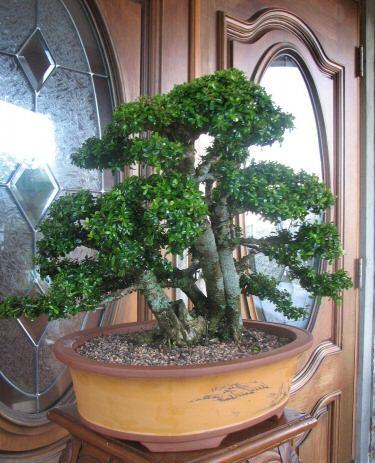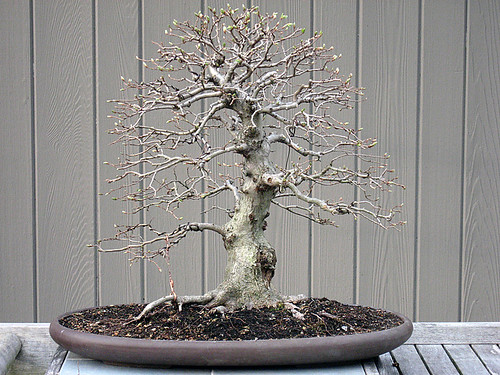Bonsai need regular pruning both above and below ground throughout their lives. How often to prune depends on how fast the particular kind of tree or bush grows, the size of the pot and the growing conditions.The first place to prune is below ground. Roots eventually fill the soil in a small bonsai pot, so they need to be pruned back to make room for fresh soil. Root-prune deciduous bonsai in early spring or late autumn, and evergreen bonsai in early spring or late summer.The way to root prune is to lift the plant out of its pot and slice back the root ball all around and underneath with a sharp knife. After teasing roots on the outside of the ball outwards, put the plant back in the pot and pack new soil among the roots. Using a stick _ a chopstick is appropriate _ to pack down the soil makes sure that no air spaces are left which would dry out the roots.Now turn your attention to the top portions of your bonsai. The time to prune the stems is now, while the plant is dormant, and then again while it is actively growing.Bonsai respond to stem pruning just as other plants do. Pinch off the tips of any shoots whose growth you want to slow. Shorten a stem where you want the remaining part to branch. Rub off buds or cut stems back to their origins where growth is congested. To make a pine, spruce or juniper bonsai bushier, pinch back the new growth just as its expanding.Because bonsai are viewed at such close range, you'll want to make pruning cuts especially neat. Avoid damaging the remaining leaves when you shorten expanding growth on spruce, for example, by reaching within a tuft of foliage with a pair of tweezers to tweak off all but a few new leaves. Fiskars and ARS make small, fine-pointed pruning shears that are ideal for working with bonsai.
Some bonsai benefit from having all their leaves pruned off just after they fully expand. Timed correctly, this leaf-pruning forces a second flush of leaves that are smaller and, hence, better proportioned to the plant.As an added benefit, that second flush of leaves often offers more dramatic autumn color than the first flush would have.On some trees, such as maples and elms, you can leaf-prune twice each season, as the first and second flush of leaves fully expand. If there is any chance of injuring buds at the bases of the leaf stalks, just cut off most of each leaf with a scissors or small pruning shear. The stalk will come off, perhaps needing some help from you, as new leaves appear.Leaf pruning is not for every bonsai. Don't do it on evergreens or on fruiting bonsai that are bearing fruit. And leaf-pruning is stressful, so avoid it on any tree that is weak or sick.The rigorous root and shoot pruning needed for bonsai is itself weakening, so take extra care to give bonsai perfect growing conditions in every other respect. This means water and fertilizer as needed, as well as good light. Many bonsai are dwarfed, cold-hardy trees and, as such, like to be kept as cool as possible this time of year.
Monday, March 9, 2009
Wednesday, March 4, 2009
Watering Bonsai trees
The most complicated part of taking care of your Bonsai is to water it properly.

Watering Bonsai trees
How often a tree needs to be watered depends on several factors (like tree species, size, size of pot, time of year, soil-mixture and climate), which means that it is impossible to say how often you should water Bonsai. However, understanding a few basic guidelines will help you to observe when a tree needs to be watered.

Watering Bonsai trees
As mentioned above, how often to water your Bonsai depends on too many factors for us to give an exact time schedule. Instead, you need to learn to observe your trees and know when they need to be watered. Using the following basic guidelines will help you to water right.
Water your trees when the soil gets slightly dry. This means you should not water your tree when the soil is still wet but only when it feels slightly dry; use your fingers to check the soil at around one centimeter (0.4’’) deep. Once you get more experienced you will be able to see (instead of feeling) when a tree needs watering.

Never water on a routine. Keep observing your trees, one by one, instead of watering them on a daily basis.Use the right soil-mixture. The soil-mixture greatly influences how often trees need to be watered, for most Bonsai trees a mixture of akadama, fine gravel and potting compost mixed together in a ratio of ½ to ¼ to ¼ should be fine. However, use a mixture that retains more water (by using more potting compost) when you cannot water your trees that regularly.
It does not really matter at what time you water a Bonsai; however, try to avoid watering during the afternoon, when the soil has been warmed up by the sun and will cool down rapidly when using cold water.
As explained, a tree should only be watered when the soil gets slightly dry. When the tree does require water though, it needs thorough soaking so the entire root system is wetted. To do so, keep watering until water runs out of the drainage holes, and repeat the process about ten minutes later.
Water a tree from above using a watering can with a fine nozzle; this will prevent the soil from being washed away. Using collected rain water is better (as it doesn’t contain added chemicals), but when this is not readily available there is no real problem in using normal tap water.
Wiring of a Bonsai
Wiring of a bonsai is not done to keep the plant small, but rather is a temporary measure used to hold branches in a desired position.When wiring, try to imitate the natural curves of trees in nature.There are two types of bonsai wire available - copper wire and aluminium wire.

Wiring of a Bonsai
The size of wire used depends on the size of branch you want to train and in most part should be chosen yourself.You should purchase wire in a variety of different lengths and test it out on pruned branches from around the garden.
The safest method to use when wiring is by clenching the branch with both hands and applying the wire by slowly following it around the branch.

Wire the branch first, and then worry about bending the branch to achieve your desired shape.It is best to not water a day before wiring, and to keep the tree in shade for two weeks after wiring.
Wiring of a Bonsai
The size of wire used depends on the size of branch you want to train and in most part should be chosen yourself.You should purchase wire in a variety of different lengths and test it out on pruned branches from around the garden.
The safest method to use when wiring is by clenching the branch with both hands and applying the wire by slowly following it around the branch.

Wire the branch first, and then worry about bending the branch to achieve your desired shape.It is best to not water a day before wiring, and to keep the tree in shade for two weeks after wiring.
Wednesday, February 25, 2009
Be in a small pot-Mini bonsai

Mini bonsai is not only small bonsai, it is "really small"!
What is Mini bonsai?
A mini bonsai means a small tree with a small pot.
"How small?" you will ask. A mini bonsai may
be smaller than your hands!
What are the main ideas of mini bonsai?
1. Special: The tree must be small and have cool stem(s).
2. Old: "People respect old trees." (by my freind) 3. Cunning: Then we need a cunning pot.
What is Mini bonsai?
A mini bonsai means a small tree with a small pot.
"How small?" you will ask. A mini bonsai may
be smaller than your hands!
What are the main ideas of mini bonsai?
1. Special: The tree must be small and have cool stem(s).
2. Old: "People respect old trees." (by my freind) 3. Cunning: Then we need a cunning pot.
Sunday, February 22, 2009
Talking About Bonsai
I want to talk deeper about bonsai.
Art:
Bonsai is a kind of art,
like drawing. However,
bonsai has life.
Advantage:
A good bonsai will show
the advantage of the tree
perfectly. Like we usually
show the thick roots of
banyan bonsai.
Nature:
Follow the nature. You may
ask "Do we always follow the
nature?" No, we will keep the
advantage of the tree but get
out the disadvantage of the tree.
Main Ideas of Making Bonsai
increase:
To let the tree grow bigger or
grow beautiful branches.
decrease:
Simple meaning is "cutting".
Tuesday, February 17, 2009
Bougainvillea

My favorite kind of tree is bougainvillea. My granfather gave me this bougainvillea. Let me introduce to you.
History:
A man called Bougainville which found out bougainvillea in South America,
and used his name.
Introduction:
From South America. They are vines and shrubs. They have thrones. Their Flore scenes
are very long. They usually bloom in summer. Their other name is paper flower.
They seldom have seeds. Their flowers are small and white, but their flower buds are big and beautiful!
They mean passion.
A man called Bougainville which found out bougainvillea in South America,
and used his name.
Introduction:
From South America. They are vines and shrubs. They have thrones. Their Flore scenes
are very long. They usually bloom in summer. Their other name is paper flower.
They seldom have seeds. Their flowers are small and white, but their flower buds are big and beautiful!
They mean passion.
Subscribe to:
Posts (Atom)




